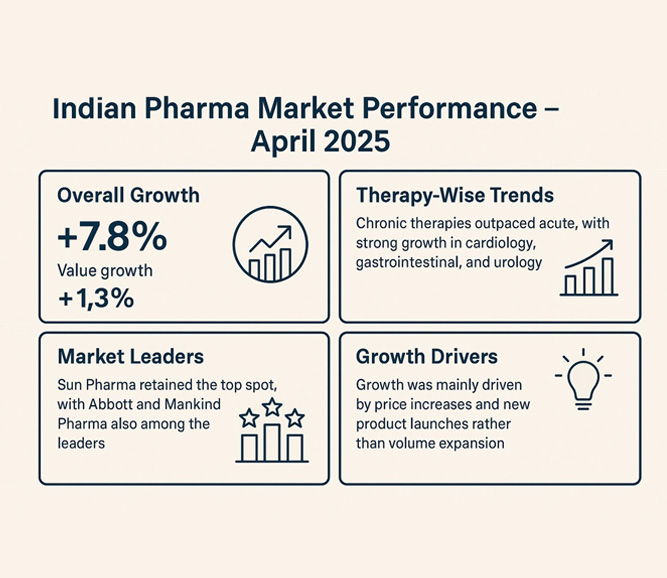
The Indian Pharmaceutical Market (IPM) maintained moderate growth in April 2025, expanding 7.8% year-on-year in value. Monthly sales reached roughly ₹19,700 crore, reflecting a continuation of the mid-single-digit growth trend seen in the first quarter of 2025.
However, volume growth remained muted at only ~1.3%, indicating that higher prices and new product sales rather than sheer increase in demand drove most of the value gain. This comes on the heels of a 7.5% growth in March and suggests a stable but price-driven market expansion going into the new fiscal year .
Chronic therapeutic areas continued to underpin the market’s momentum. PharmaTrac data for April shows chronic therapies outpaced acute therapies, mirroring a broader 2025 trend where chronic segments grew ~9–10% vs. ~6% for acute segments.
In April, anti-infectives and other acute categories saw slower growth, keeping overall IPM growth in the high single digits. Importantly for industry stakeholders, pricing power and new launches were key growth levers, while underlying demand (volume) saw only slight uptick. In the following sections, we delve into therapy-wise performance, leading companies and brands, and the drivers behind April’s growth, drawing on the PharmaTrac Industry Mailer (April 2025) insights.
Therapy-Wise Performance Highlights
Chronic therapies led the growth in April. Cardiology remained the largest therapy area, posting double-digit growth (~10–11% YoY) on a ₹30,000+ crore annual base . The gastrointestinal (GI) segment also showed robust momentum (~7% value growth in April), supported by solid volume gains, thanks to sustained demand for anti-ulcerants and digestive aids. The anti-diabetic segment grew a modest ~5–6% in value, tempered by price erosion from a major patent expiry, even as volume climbed ~4% (indicating strong underlying demand).
March 2025 saw the popular diabetes drug empagliflozin go off-patent, causing its price to plummet ~85% (from ₹60+ to ₹5–15 per tablet) as numerous generic brands hit the market. This price crash in empagliflozin dragged on April’s diabetes therapy value growth despite higher unit sales.
On the other hand, several smaller or niche therapies exhibited standout growth. Urology was the fastest growing segment in April, surging by roughly 14–15% in value (albeit from a smaller base), driven by increasing prescriptions for prostate and urinary disorder drugs.
The oncology/anti-neoplastics segment also expanded ~12% YoY, reflecting rising adoption of cancer therapies in the domestic market. Blood-related therapies (e.g. hematinics) climbed ~12–13%, and hormones grew ~10% with even higher volume uptake, indicating expanding use of hormonal treatments. Dermatology continued its healthy run with high-single-digit growth, building on one of the highest growth rates among major therapies in the past year (≈11% in FY25) .
By contrast, acute care segments lagged. Anti-infectives (antibiotics) grew only ~5–6% in value with volumes slightly declining, pointing to normalization after the pandemic-era surge – a trend confirmed by PharmaTrac’s finding of a –1.6% unit decline in anti-infectives over the past year . The vitamins/minerals segment (nutritional supplements) also rose only mid-single-digits, with volumes essentially flat or down, possibly due to a high base and market saturation of commodity vitamin brands.
Respiratory drugs (cough/cold, anti-asthmatics) showed mixed results – April saw ~7–8% growth after a subdued flu season, along with a 3% volume uptick, but this followed earlier weakness (the respiratory category’s MAT growth was barely 2.8% with volume decline over 12 months) .
Vaccines remained a drag on the market; with COVID-19 vaccine demand evaporating, the vaccines segment posted only mid-single-digit growth in value and continued to see a double-digit plunge in units (−14% YoY) .
Meanwhile, gynecological drugs and sexual health (rejuvenators) were nearly flat – gynecology grew only ~1–2%, making it one of the most sluggish categories in April. These trends reinforce that India’s pharma growth is coming largely from chronic and specialty therapies, whereas many acute treatments are experiencing a post-pandemic slowdown.
Market Leaders: Top Pharma Corporates
The competitive landscape of Indian pharma in April 2025 saw the same leaders consolidating their positions with above-market growth. Sun Pharma (including the erstwhile Ranbaxy portfolio) retained its rank #1 with about 8.3% market share and an impressive 12–13% growth in domestic sales. Sun’s strong performance – April sales grew ~13.7% YoY – stems from its broad chronic portfolio leadership in cardiometabolic, dermatology, etc., and successful new launches.
At rank #2, Abbott (combined with Abbott Healthcare and Novo Nordisk’s insulin range) held roughly 6% share. Abbott grew around 7–8%, a steady performance fueled by its diabetes and thyroid hormone franchises . Mankind Pharma (with Bharat Serums) emerged as the third-largest player, also near 6% share. While Mankind’s MAT growth was ~9%, it saw a somewhat slower April (single-digit) as some acute-focused brands faced headwinds.
Cipla and Alkem rounded out the top five corporates, each with about 5% and 4% market share respectively . Cipla’s domestic business grew in high single digits for the year, but notably accelerated to double-digit growth in April (≈11% YoY) thanks to its respiratory and chronic products gains. Alkem (including its subsidiaries like Cachet) grew ~7–8% and benefited from a mix of acute and chronic brands, with strong anti-diabetic and gastrointestinal portfolios.
Several other mid-to-large firms reported robust April growth. For example, Torrent Pharma (now boosted by Curatio’s derma portfolio) delivered around 14% YoY growth in April, among the highest in the top 10. Intas too maintained double-digit growth (~12%), leveraging its oncology and chronic drug strengths.
Dr. Reddy’s Labs posted ~10–11% growth, aided by new product introductions in therapies like diabetes and vaccines. Zydus Lifesciences saw high single-digit growth (~8%), a bit slower than prior months . In contrast, some companies with an acute-care tilt grew more modestly – e.g., Aristo Pharma and Macleods (known for antibiotics and acute therapies) managed only low-single-digit growth around 2–4% in April (well below industry average). These variations underscore a clear trend: companies with strong chronic and specialty portfolios (cardiac, anti-diabetic, derma, etc.) are outperforming, while those reliant on acute segments are lagging.
Overall, the top 10 corporations collectively outpaced the market, gaining share through aggressive new launches and deeper penetration into chronic diseases. According to Pharmarack’s FY25 data, Sun Pharma’s domestic revenue (MAT ₹18,657 Cr) grew 12.4%, expanding its leadership.
Abbott+Novo grew ~7–8% to ₹13,306 Cr, and Mankind+Bharat Serums grew 9.5% to ₹12,880 Cr. This healthy competitive growth suggests that even in a moderate market, leading firms are finding ways to drive double-digit growth – primarily by focusing on high-growth therapies, brand building, and leveraging innovation. Pharma executives should note the importance of therapeutic mix and innovation in driving outperforming growth within the Indian market.
Top Brands and Notable Brand Performances
Indian pharma brand rankings saw both consistency at the top and dynamic shifts lower down. The top-selling brands (MAT) for the 12 months ending April 2025 are dominated by chronic and legacy products:
1. Augmentin (GSK) – ₹816 crore in annual sales . This broad-spectrum antibiotic (amoxicillin/clavulanate) remains the #1 brand in India. It grew ~5.7% YoY, a respectable uptick for a mature anti-infective, reflecting sustained high volume usage post-COVID .
2. Glycomet-GP (USV) – ₹803 crore . A leading anti-diabetic (glimepiride + metformin), Glycomet GP is the #2 brand. Its growth was a modest ~3%, indicating intense competition in diabetes care, especially after new generics (e.g., empagliflozin combos) entered the market .
3. Pan 40 (Alkem) – ₹774 crore . A popular proton-pump inhibitor for acidity, Pan maintained the #3 rank. It posted a strong 10% growth aided by rising GI prescriptions and perhaps some price increase . (Notably, its variant Pan D – a combination formula – was one of the fastest-growing major brands.)
4. Mixtard (Abbott/Novo) – ₹772 crore . This human insulin (distributed by Abbott) is a staple diabetes therapy. Mixtard’s value growth was only ~1–2%, indicating a flat insulin market with price controls, though volumes remain high. New analog insulins are slowly chipping away at Mixtard’s share.
5. Liv.52 (Himalaya) – ₹731 crore . A herbal liver supplement, Liv.52’s inclusion in the top 5 underscores the sizable nutraceutical market in India. Impressively, it grew about 11.8% as consumer health and preventive medicine trends drive uptake .
Outside the top five, other notable brands included Foracort (Cipla) for asthma (≈₹731 Cr, 3% growth), Clavam (Alkem) antibiotic, Monocef (Aristo) antibiotic, Thyronorm (Abbott) for thyroid, and Telma (Glenmark) for hypertension – all fixtures in the top 20 brands list. GSK’s Augmentin and USV’s Glycomet GP swapping monthly ranks in April (Glycomet was the #1 brand in April 2025 sales, while Augmentin was #3 for the month) shows that chronic brands can lead in individual months, though acute blockbusters still dominate MAT rankings.
Crucially, high-growth brands are injecting dynamism into the market. Alkem’s Pan D (pancreatic enzyme + domperidone) grew by 17% YoY, riding on increased use of combo GI therapies. Mankind’s Manforce (a male wellness product) surged by 15–18% YoY, reflecting aggressive marketing and expanding OTC demand . Another big mover is Ryzodeg (insulin analog, Novo/Abbott), which saw a whopping ~30% growth (MAT ₹593 Cr) as a newer diabetes therapy gaining acceptance. These growth rates far outstrip the market and highlight where demand is rising – specialty products and newer therapies. Even established brands can show spikes: Thyronorm (thyroid hormone) grew ~14%, benefiting from India’s large untreated thyroid patient pool. On the flip side, a few older brands plateaued or declined – for instance, Janssen’s Ultracet (painkiller) saw a slight dip (≈–1% growth) due to competition.
For pharma marketers, the brand rankings reinforce the value of legacy brands with broad indications, but also the importance of new product introductions and lifecycle management. The fact that 86 brands from 19 companies launched generics of empagliflozin in March 2025 immediately after patent expiry shows how quickly the market can shift. While none of those new entrants are top 20 yet, their collective impact is significant – a rapid commoditization that lowered the average price in that drug category. In contrast, innovative launches like tirzepatide (Mounjaro) for diabetes/obesity, though starting small (₹1.4 Cr sales in its first month), represent future growth areas as India’s metabolic disorder burden rises. Pharma brands that address emerging lifestyle diseases or offer novel benefits are poised to climb the ranks in coming years.
Growth Drivers and Strategic Insights
April 2025’s performance highlights several strategic insights for pharma business leaders. First, the growth drivers were primarily pricing and new launches rather than volume. Pharmarack’s analysis for the Jan–Mar quarter showed about 5.3% of growth coming from price increases, only 0.2% from pure volume uptick (with the remainder from new product sales) . April’s 7.8% value growth appears to be a continuation of this pattern – in other words, companies raised prices (within permissible limits) and augmented portfolios with new products to drive revenue growth, while underlying demand grew modestly. This price-led growth is evident from the low unit growth (+1.3% ) and was enabled by factors like annual WPI-linked price hikes and a richer product mix. However, relying on price hikes has its limits: regulators in India are increasingly vocal about keeping medicines affordable, and policy shifts (such as encouraging more generics substitution) could pressure this model . Pharma executives should therefore strategize for a scenario where volume growth and market expansion become paramount. Expanding patient access (especially in semi-urban/rural areas) and improving medication adherence in chronic diseases could unlock higher volume growth to complement pricing.
Second, new product innovation and timely launches are critical. The Indian market sees thousands of brand launches annually – over 3,200 new brands were launched in the past year, contributing ~6.5% of the market’s incremental growth . April’s data reiterate that companies who rapidly introduce new therapies (or generic versions of newly off-patent drugs) capture additional share. The case of empagliflozin generics flooding the market in March-April is a clear example: firms that moved quickly gained a slice of that pie, albeit at lower price points . Likewise, the double-digit growth of novel drugs like tirzepatide, or even the strong uptake of a new insulin like Ryzodeg, shows Indian prescribers and patients are adopting innovative treatments when available. For pharma marketers, this means that pipeline and launch excellence are key strategic priorities – being first or fast-to-market with new drugs (and differentiating them effectively) can be a significant growth driver in an otherwise moderate-growth environment.
Third, the therapy mix of the market is evolving. Chronic diseases (cardiac, diabetes, CNS, etc.) now contribute a growing share of India’s pharma sales – roughly a third of the market by value comes from just cardiac, GI, and anti-diabetic therapies . These segments grew 8–11% in FY25, outpacing overall growth . An aging population, rising lifestyle diseases, and urbanization are fueling this chronic boom. For companies, aligning portfolios with chronic care (and associated specialty areas like oncology and nephrology) will be crucial for long-term growth. Acute therapies, while large, are seeing slower momentum and are more susceptible to seasonality and antibiotic stewardship efforts. The subdued growth in anti-infectives and vitamins in April underscores this point – acute brands need smarter marketing and perhaps volume pushes to avoid stagnation. Additionally, as the COVID-era surge subsides, categories like respiratory and vitamins need innovation (e.g. new combinations, indication expansion) to reignite growth.
Finally, market consolidation and brand equity continue to play a role. The fact that the top 20 companies account for a dominant share of the market (Sun alone ~8%, top 10 over 50%) means larger players with established brands have an advantage in pushing through price increases and garnering doctor mindshare. However, up-and-comers like Mankind and Eris are proving that focused strategies can break through, especially in high-growth niches. The 8.4% overall growth of FY2024-25 for IPM  was achieved on the back of broad-based positive growth across major therapies and players. Going forward, pharma executives should monitor policy changes (e.g., drug price controls, generic substitution initiatives) and competitive moves (like mergers or big patent expiries) that could alter growth dynamics. The April 2025 data already hints at these shifts – with patent expirations creating one-time distortions and new launches adding fresh revenue streams.
In summary, April 2025 was a month of steady, if unspectacular, growth for the Indian pharma industry, reinforcing trends seen throughout early 2025. The market grew in high single digits, propelled by price hikes and new products, while volume growth stayed low. Chronic therapies and top companies outperformed, highlighting where the momentum lies (in lifestyle and specialty segments and with innovation-driven firms). Acute and commoditized areas underperformed, pulling back overall growth. For pharma marketers and business strategists, the key takeaways are to focus on chronic care opportunities, drive innovation/new launches, and find ways to boost volume uptake in a price-conscious environment. Maintaining growth in the Indian market will require balancing the short-term gains from pricing with long-term strategies around patient reach, brand building, and portfolio enhancement. With the right strategic moves, pharma companies can build on the April 2025 performance to achieve sustained success in the coming quarters.
Sources: PharmaTrac, Business-standard, Medical Dialogues and industry news analysis.







